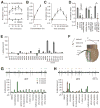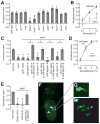Drosophila TRPA1 channel is required to avoid the naturally occurring insect repellent citronellal
- PMID: 20797863
- PMCID: PMC2946437
- DOI: 10.1016/j.cub.2010.08.016
Drosophila TRPA1 channel is required to avoid the naturally occurring insect repellent citronellal
Abstract
Plants produce insect repellents, such as citronellal, which is the main component of citronellal oil. However, the molecular pathways through which insects sense botanical repellents are unknown. Here, we show that Drosophila use two pathways for direct avoidance of citronellal. The olfactory coreceptor OR83b contributes to citronellal repulsion and is essential for citronellal-evoked action potentials. Mutations affecting the Ca(2+)-permeable cation channel TRPA1 result in a comparable defect in avoiding citronellal vapor. The TRPA1-dependent aversion to citronellal relies on a G protein (Gq)/phospholipase C (PLC) signaling cascade rather than direct detection of citronellal by TRPA1. Loss of TRPA1, Gq, or PLC causes an increase in the frequency of citronellal-evoked action potentials in olfactory receptor neurons. Absence of the Ca(2+)-activated K(+) channel (BK channel) Slowpoke results in a similar impairment in citronellal avoidance and an increase in the frequency of action potentials. These results suggest that TRPA1 is required for activation of a BK channel to modulate citronellal-evoked action potentials and for aversion to citronellal. In contrast to Drosophila TRPA1, Anopheles gambiae TRPA1 is directly and potently activated by citronellal, thereby raising the possibility that mosquito TRPA1 may be a target for developing improved repellents to reduce insect-borne diseases such as malaria.
Copyright © 2010 Elsevier Ltd. All rights reserved.
Figures




Similar articles
-
The Mosquito Repellent Citronellal Directly Potentiates Drosophila TRPA1, Facilitating Feeding Suppression.Mol Cells. 2015 Oct;38(10):911-7. doi: 10.14348/molcells.2015.0215. Epub 2015 Oct 12. Mol Cells. 2015. PMID: 26447139 Free PMC article.
-
Activation of Drosophila melanogaster TRPA1 Isoforms by Citronellal and Menthol.Int J Mol Sci. 2021 Oct 12;22(20):10997. doi: 10.3390/ijms222010997. Int J Mol Sci. 2021. PMID: 34681657 Free PMC article.
-
Heat activation desensitizes Aedes aegypti transient receptor potential ankyrin 1 (AaTRPA1) to chemical agonists that repel mosquitoes.Pestic Biochem Physiol. 2025 Apr;209:106326. doi: 10.1016/j.pestbp.2025.106326. Epub 2025 Feb 11. Pestic Biochem Physiol. 2025. PMID: 40082023
-
Temperature sensation in Drosophila.Curr Opin Neurobiol. 2015 Oct;34:8-13. doi: 10.1016/j.conb.2015.01.002. Epub 2015 Jan 21. Curr Opin Neurobiol. 2015. PMID: 25616212 Free PMC article. Review.
-
The regulations of Drosophila phototransduction.J Neurogenet. 2012 Jun;26(2):144-50. doi: 10.3109/01677063.2011.650253. Epub 2012 Mar 15. J Neurogenet. 2012. PMID: 22420370 Review.
Cited by
-
Molecular correlates of swarming behaviour in Aedes aegypti males.Biol Lett. 2024 Oct;20(10):20240245. doi: 10.1098/rsbl.2024.0245. Epub 2024 Oct 30. Biol Lett. 2024. PMID: 39471837 Free PMC article.
-
Bitter-sensitive gustatory receptor neuron responds to chemically diverse insect repellents in the common malaria mosquito Anopheles quadrimaculatus.Naturwissenschaften. 2016 Jun;103(5-6):39. doi: 10.1007/s00114-016-1367-y. Epub 2016 Apr 23. Naturwissenschaften. 2016. PMID: 27108454
-
Ticks home in on body heat: A new understanding of Haller's organ and repellent action.PLoS One. 2019 Aug 23;14(8):e0221659. doi: 10.1371/journal.pone.0221659. eCollection 2019. PLoS One. 2019. PMID: 31442282 Free PMC article.
-
Chemoreceptor proteins in the Caribbean spiny lobster, Panulirus argus: Expression of Ionotropic Receptors, Gustatory Receptors, and TRP channels in two chemosensory organs and brain.PLoS One. 2018 Sep 21;13(9):e0203935. doi: 10.1371/journal.pone.0203935. eCollection 2018. PLoS One. 2018. PMID: 30240423 Free PMC article.
-
Molecular characterization of larval peripheral thermosensory responses of the malaria vector mosquito Anopheles gambiae.PLoS One. 2013 Aug 7;8(8):e72595. doi: 10.1371/journal.pone.0072595. Print 2013. PLoS One. 2013. PMID: 23940815 Free PMC article.
References
-
- Reeder NL, Ganz PJ, Carlson JR, Saunders CW. Isolation of a deet-insensitive mutant of Drosophila melanogaster (Diptera: Drosophilidae) J Econ Entomol. 2001;94:1584–1588. - PubMed
-
- Ditzen M, Pellegrino M, Vosshall LB. Insect odorant receptors are molecular targets of the insect repellent DEET. Science. 2008;319:1838–1842. - PubMed
-
- Katz TM, Miller JH, Hebert AA. Insect repellents: historical perspectives and new developments. J Am Acad Dermatol. 2008;58:865–871. - PubMed
-
- Vosshall LB, Stocker RF. Molecular architecture of smell and taste in Drosophila. Annu Rev Neurosci. 2007;30:505–533. - PubMed
-
- Smith DP. Odor and pheromone detection in Drosophila melanogaster. Pflugers Arch. 2007;454:749–758. - PubMed
Publication types
MeSH terms
Substances
Grants and funding
LinkOut - more resources
Full Text Sources
Molecular Biology Databases
Miscellaneous

